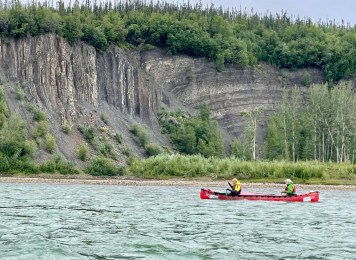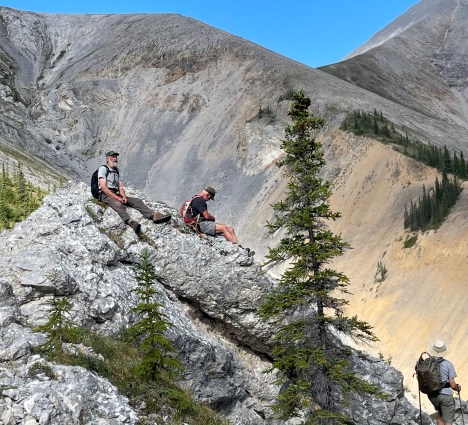Cobbled Together

Going to primal places helps me sort things out. Such as it was this past summer when six of us joined a remote Yukon river for quietude and a geology lesson. At our very first campsite we learned that the river too had sorted out things on its own.
In looking for campsites over the sixteen days of paddling, we couldn’t be that choosy as the river banks were steep, heavily forested or stalwart cliffs. Consequently we ended up camping mostly on top of riverine rocks known as cobble. These are rocks rounded by millennia of water surging, flowing, pushing and trickling. They ranged from golf ball-shaped to almost volleyball in size. We were glad that we could push or toss enough aside to to make a reasonable tent pad. And gladder yet that we each had a fairly cushy sleeping pad to lay over the lumpy ground to serve as a bed.
In the first few days the cobble seemed almost an irritant but then as we learned to live with it we became more cognizant of the workings of a river. It is mesmerizing to think that the countless cobble we paddled over and slept on were once part of the bones of the ancient mountains surrounding high above us.

The tireless, clear river, powered by gravity combined with a continual gradient, shot our canoes over the blurry mosaic of rocks. We marveled at the speed of the current. My bowman, Mike, used his phone to determine speed and more than once he would call out, “Eight klicks! No, ten klicks!!” (A klick is a kilometer and ten klicks converts to six miles per hour.) For the record, a recreational, flatwater paddler paddling at a fast cadence is lucky to maintain 5 mph for an extended period of time.
We wondered about the power of spring breakup and the ensuing rush of meltwater. It would be enough to tumble these rounded boulders and rocks further and further downstream. As spring matures, the current slows and the heavier rocks would pause first. Then the lesser rocks would settle and finally the gravel and sand would settle out at the downstream end of the rocky shoals.
Surrounded by a discombobulated library of igneous, sedimentary and metamorphic rocks, Mike and I regretted our geological ignorance. As if that visible strewn puzzle wasn’t enough, we couldn’t fathom what was being blended below the crust of the earth in the tireless, roiling, mixing of minerals combined with heat and pressure.
Paddling by massive rock walls formed by geological folding and faulting had us asking more questions.

Mike particularly grew fond of stones that resembled hard mudballs made up of small, marble and pea-sized stones cemented together. Only later, after some geologic investigating did I learn that these are glacial relics called diamictites.

The collection of various stones found in the conglomeration were diverse in their own origin. At one point in their history, they had been scraped up and carried for a slow ride on a glacier. Finally, after perhaps centuries of moving, the climate warmed and the glacier began to recede. At the melting terminus of the ice lobe there is usually an ocean or a large body of glacial meltwater.
Imagine a piece of that glacier, falling into the water where it floats as an iceberg pitted with the small stones. Eventually the floating ice melts and the stone cargo sinks to the muddy bottom. Centuries pass and the plopped stones are now congealed in mudstone. Another ice age descends and the massive moving sheet of ice breaks up the mudstone with its cemented small rocks into chunks of various sizes.
From one campsite, we were seduced by a distant peak. Several of us donned day packs with stowed lunches, water bottles and rain gear and headed uphill.
We eventually left the rocky wash and began to zigzag up through the park-like spruce anchored to the steep slope. Halfway up, a small flock of boreal chickadees flitted next to me. Their hoarse steady calls almost seemed to encourage me to keep climbing.

Finally three of us broke through the treeline into the alpine. Higher up we walked among limestone shards. Near the top we paused under the slight lean of a house-sized limestone outcropping. Dark clouds and distant thunder urged us to don our rain jackets and tuck in close to lime behemoth to avoid becoming lightening rods. We pulled up our hoods to fend off being pelted by tiny hail, called graupel.
Soon the winds carried the surly clouds away. The sunshine returned to us as we marveled at the irony of standing among the remains of ancient seabeds perched on top of this mountain peak.
After our high altitude beach combing, we began the long and slow descent back to our riverside cobbled camp.
With a deliberate descent, carefully watching each step, I would occasionally pause and look up at the landscape ravaged by water, wind and time. We purposefully avoided walking single file so as not to endanger those downhill of a runaway rock. Occasionally a step would loosen a rock and send it bouncing and clacking downhill. It is very likely that the dislodged rock would someday feel the flow of water as it begins the long slow saga of whittling a mountain to rounded cobble and eventually grains.
Perhaps future paddlers might contemplate one of the rocks we accidentally loosened from the mountain top and sent to join a gathering of waters. Who knows, maybe that once-leaping rock just might settle along the river and uncomfortably poke a sleepy camper’s hip.

Note: Thanks to author/geologist Marcia Bjornerud for introducing me to diamictites in her fine memoir Discovering the Subtle Wisdom of Rocks.
